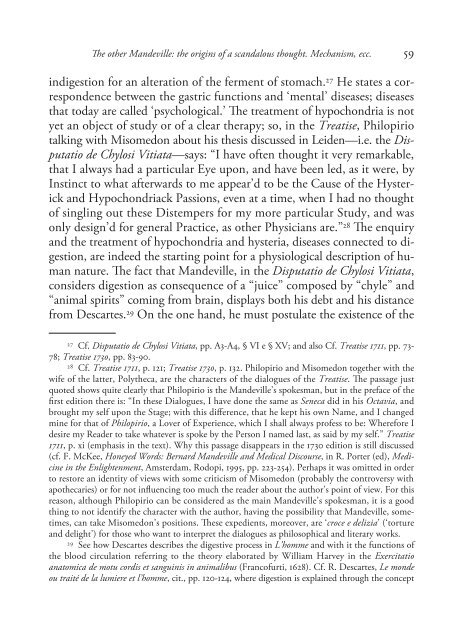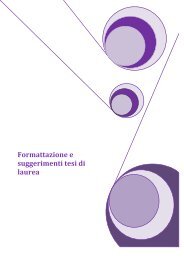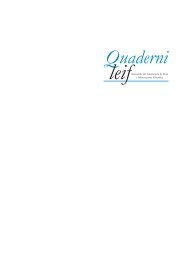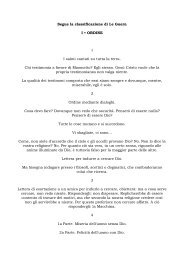qui - maria vita romeo
qui - maria vita romeo
qui - maria vita romeo
You also want an ePaper? Increase the reach of your titles
YUMPU automatically turns print PDFs into web optimized ePapers that Google loves.
e other Mandeville: the origins of a scandalous thought. Mechanism, ecc. 59<br />
indigestion for an alteration of the ferment of stomach. 27 He states a correspondence<br />
between the gastric functions and ‘mental’ diseases; diseases<br />
that today are called ‘psychological.’ e treatment of hypochondria is not<br />
yet an object of study or of a clear therapy; so, in the Treatise, Philopirio<br />
talking with Misomedon about his thesis discussed in Leiden—i.e. the Disputatio<br />
de Chylosi Vitiata—says: “I have often thought it very remarkable,<br />
that I always had a particular Eye upon, and have been led, as it were, by<br />
Instinct to what afterwards to me appear’d to be the Cause of the Hysterick<br />
and Hypochondriack Passions, even at a time, when I had no thought<br />
of singling out these Distempers for my more particular Study, and was<br />
only design’d for general Practice, as other Physicians are.” 28 e en<strong>qui</strong>ry<br />
and the treatment of hypochondria and hysteria, diseases connected to digestion,<br />
are indeed the starting point for a physiological description of human<br />
nature. e fact that Mandeville, in the Disputatio de Chylosi Vitiata,<br />
considers digestion as consequence of a “juice” composed by “chyle” and<br />
“animal spirits” coming from brain, displays both his debt and his distance<br />
from Descartes. 29 On the one hand, he must postulate the existence of the<br />
27 Cf. Disputatio de Chylosi Vitiata, pp. A3-A4, § VI e § XV; and also Cf. Treatise 1711, pp. 73-<br />
78; Treatise 1730, pp. 83-90.<br />
28 Cf. Treatise 1711, p. 121; Treatise 1730, p. 132. Philopirio and Misomedon together with the<br />
wife of the latter, Polytheca, are the characters of the dialogues of the Treatise. e passage just<br />
quoted shows <strong>qui</strong>te clearly that Philopirio is the Mandeville’s spokesman, but in the preface of the<br />
first edition there is: “In these Dialogues, I have done the same as Seneca did in his Octavia, and<br />
brought my self upon the Stage; with this difference, that he kept his own Name, and I changed<br />
mine for that of Philopirio, a Lover of Experience, which I shall always profess to be: Wherefore I<br />
desire my Reader to take whatever is spoke by the Person I named last, as said by my self.” Treatise<br />
1711, p. xi (emphasis in the text). Why this passage disappears in the 1730 edition is still discussed<br />
(cf. F. McKee, Honeyed Words: Bernard Mandeville and Medical Discourse, in R. Porter (ed), Medicine<br />
in the Enlightenment, Amsterdam, Rodopi, 1995, pp. 223-254). Perhaps it was omitted in order<br />
to restore an identity of views with some criticism of Misomedon (probably the controversy with<br />
apothecaries) or for not influencing too much the reader about the author’s point of view. For this<br />
reason, although Philopirio can be considered as the main Mandeville’s spokesman, it is a good<br />
thing to not identify the character with the author, having the possibility that Mandeville, sometimes,<br />
can take Misomedon’s positions. ese expedients, moreover, are ‘croce e delizia’ (‘torture<br />
and delight’) for those who want to interpret the dialogues as philosophical and literary works.<br />
29 See how Descartes describes the digestive process in L’homme and with it the functions of<br />
the blood circulation referring to the theory elaborated by William Harvey in the Exercitatio<br />
anatomica de motu cordis et sanguinis in animalibus (Francofurti, 1628). Cf. R. Descartes, Le monde<br />
ou traité de la lumiere et l’homme, cit., pp. 120-124, where digestion is explained through the concept








